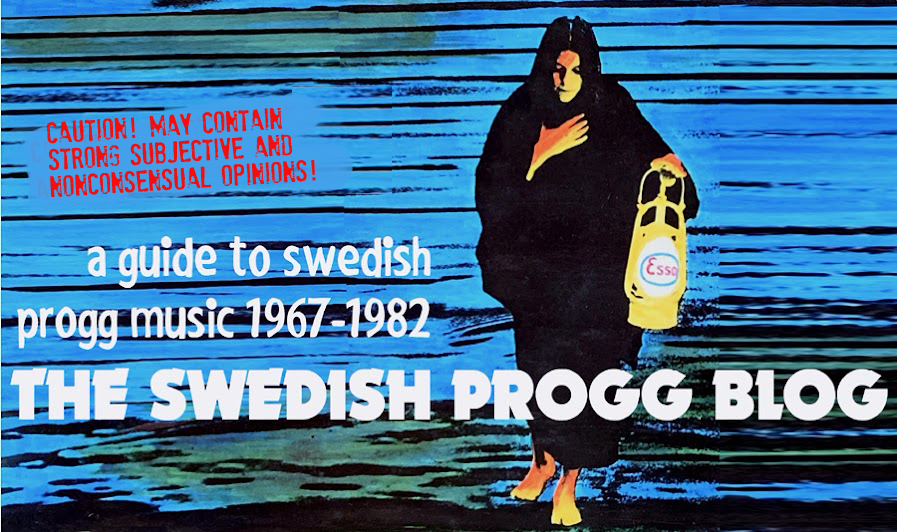Tuesday, July 31, 2018
STEN BERGMAN – Lyckohjulet (Gump, 1974)
ELDA MED HÖNS – Elda Med Höns (MNW, 1975)
RÖDA ROPET – Spänn bågen (Ungkommunisters Förlag, 1975)
AGÖ FYR – Agö Fyr (Forsaljud, 1977) / Mjölnarens måg (Forsaljud, 1978)
VARGEN – I original (YTF, 1975)
”I original” is lowly regarded by many, and it's understandable. Opening track ”Monte Bello” is decent compared to the rest of the album, and ”Vodka och whisky” sounds like Contact leftover, but the rest of the album is uninspiring (and uninspired).
Full album playlist
MARIE SELANDER – Från den svenska vildmarken (MNW, 1973)
CLAES EKENSTAM & SISTA BANDET – Sista tåget till Tasjkent (Sista Bussen, 1979)
GUNDER HÄGG / BLÅ TÅGET – Albums 1969-1974
Special thanks to Roland Keijser for shedding some light on his departure, and Carl Johan De Geer for letting me use his classic picture.
ROCKVATTNÄ – Rockvattnä (Ljudbarrikaden, 1979)
ELISABET HERMODSSON – Vad gör vi med sommaren, kamrater? (Proprius, 1973) / Disa Nilssons visor (Caprice, 1975) / Vakna med en sommarsjäl (Caprice, 1979)
SALT – Salt (Signatur, 1977) / Opus II (Signatur, 1980)
GÖRAN PERSSON – Blir jag sen spelkarl (MNW, 1972) / Hundliv (MNW, 1974)
Persson made another album in 1996, ”På Siljan”.
FRIENDSHIP TIME – Friendship Time (Mellotronen, 2006; recorded 1975)
BLUES ANNIKA – Blues Annika (Nacksving, 1980)
International relevance: **
After Annika Dahlqvist's 1974-1977 stint with Albins Bluesband she was already an experienced singer when she recorded her first and only album, with all original material bar a Swedish language cover of blues classic ”Nobody Knows You When You're Down and Out”. The album made quite some rumble upon its release in 1980, and Blues Annika soon became nationally known for her honest lyrics where she managed to transfer the original blues vocabulary into a functioning Swedish counterpart. The blues was more than a pose and a nickname – she had led a hard life in Gothenburg's netherworld of drug addicts but is said to have kicked her habits when she recorded her album with The Freelancers, a backing band featuring familiar Gothenburg progg characters including Hannes Råstam and Bengan Blomgren.
Blues Annika is also featured with one track on Nacksving compilation ”Från flykt till kamp”.
Amazingly enough, live tapes of Albins Bluesband have survived and is up on Youtube for all to hear: (1) (2) (3) (4) (5)
ULF BEJERSTRAND – Ett spel i röven (Grisbäck, 1978)
The album isn't very good even if you don't understand his puerilities, but at least it has two good tracks, both instrumental. But it should be said that ”Min låt” and ”Mjäll i tårtan” aren't good only because Bejerstrand is kind enough to keep his mouth shut on those tracks.
CONTACT – Complete albums 1969-1972
- I tell you, it caused one heck of an outcry. For instance, we were put on trial before a 'public court' with people from Silence and some others too... 'Public court' was irony. Silence might have been out fishing for us when we left MNW. But the meeting was probably more about some obscure principles...
”Utmarker” kicks off with one of the greatest progg tracks ever, ”Fyrvaktarns dotter”, again in a folk inspired vein but even better than the famous ”Hon kom över mon”. The track was also released as a single with the brilliant non-album track ”Fly mig en sommar” on the 'B' side. With a major label budget to back them up, they made a bigger sounding album without losing their integrity. ”Utmarker” is a better album overall than ”Hon kom över mon”, with more distinctive songwriting from Ström, Steerling and de Wolfe alike.
Special thanks to Ted Ström.
Nobody Wants to Be Sixteen full album playlist
ÄNGLABARN – Änglabarn (Plump Productions, 1973)
TOMAS FORSSELL – Nya tider (Avanti, 1980)
Monday, July 30, 2018
ZAMLA MAMMAZ MANNA – Familjesprickor (Silence, 1980)
BERITS HALSBAND – Berits Halsband (Forsaljud, 1975)
PYRAMID – First Stone (Sfinx, 1978)
MÅNS MOSSA – Måns Mossa (Great Music Production, 1979)
Full album playlist
Sunday, July 29, 2018
ARCHIMEDES BADKAR & AFRO 70 – Bado Kidogo (MNW, 1978)
Archimedes Badkar trumpeter Tommy Adolfsson sheds some light on how the two bands got in touch with each other:
”Kila Mtu” makes for a strong opening but the very best moment is the album's final 12+ minutes of Ghanaian funeral music, ”Darafo/Darkpen” with saxophonists Jörgen Adolfsson and Christer Bothén blowing hard and free before the rest of the band works up an irrestistable groove around Bengt Berger's xylophone and Per Tjernberg's percussion.
Although being outside the time span of this blog, I'd really like to mention two Archimedes Badkar related albums. The first of them i ”Trancedance” (Organic Music/Urspår) by Christer Bothén featuring Bolon Bata, released in 1984, with a massive line-up of former Archimedes Badkar members such as Bengt Berger, Jörgen Adolfsson and Tommy Adolfsson and numerous other progg luminaries. A fantastic, hard swinging, afro inspired feast of an album. The second album was released in 1987 by Bengt Berger lead Bitter Funeral Beer Band's ”Praise Drumming” (Dragon) and features several of the people who made ”Trancedance”, and follows along the same lines albeit broadening the stylistic range even more. Another must for Archimedes Badkar fans.
Special thanks to Tommy Adolfsson for kindly taking the time to straighten some things out!
EGBA – The 1970's albums
Instrumental, other languages
Instrumental, other languages
International relevance: ***







































